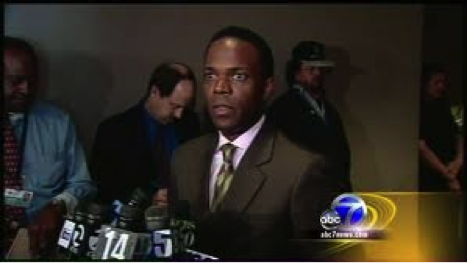(F&H “California Employment” poster Michael Bernick, former state EDD director, was a member of BART Board of
Directors 1988-1996, and today is a regular BART rider).
Hooray for BART! For BART Board President Bob Franklin, Vice
President John McPartland and the Board of Directors; for acting General
Manager Sherwood Wakeman; for BART spokesperson Linton Johnson (shown below);
and for the new BART police chief Kenton Rainey.
Last Thursday, August 11, BART officials learned via
Facebook that a group, No Justice No BART, was threatening to shut down the San
Francisco Civic Center station, and disrupt the evening commute. The group
previously had shut down the Civic Center station at the evening commute on
July 11, in protest of the shooting by BART police of Mr. Charles Hill.

The shooting of Mr. Hill does raise very disturbing
questions. Mr. Hill allegedly was drunk and may have been wielding a knife.
However, it’s not clear what degree of threat he poised once police arrived,
and he appears to have had mental illness issues. BART, though, responded
immediately by launching an independent investigation, and several BART
Directors are closely monitoring it.
Over the past decade, the local governments of San Francisco
and Oakland have responded to protesters shutting down public transit (and
roadways) with an attitude of “what can we do”. Protesters are to be allowed
not only peaceful protest, but any disruptions. Commuters, both on public
transit and in cars, are considered secondarily or not at all.
Last Thursday, BART said “Enough”. It deployed a strong police presence at the station to
protect commuters. It also turned off cell phone access at the Civic Center, to
halt the increasing practice by protest groups of using twitter and social
media to coordinate disruption techniques in real time.
The cell phone access was met with denunciations by the
local American Civil Liberties Union (ACLU) and by another non-profit law
group, the Electronic Frontier Foundation, whose attorney rushed for publicity.
These groups compared BAT’s cell phone policy with the Mubarak regime in Egypt
and with “repressive” regimes throughout the world.
The comparison, of course, is ludicrous. As Linton Johnson calmly
noted, the cell phone stoppage was only at the one station, and for a short
time; and people who needed to use a phone for an emergency could contact the
station agent.
I might add a comment about the Civic Center station, as it
was my “home” station for several years. In the late 1970s and early 1980s I
lived up the street from the station, during the time I headed a job training
agency in a nearby area (I had the quaint Dorothy Day/Michael Harrington idea
then that those who work with the poor should live with the poor). The people
accessing this station then as now include
the government workers, usually clerical and mid-level, who work in the
nearby buildings. Mainly, though, they are the transit-dependent population of
the area-students, immigrants, men living in the SROs of the area. These people
depend on BART and MUNI to get to school or work, to run errands, to meet daily
needs and routines.
So Hooray for Linton Johnson; Hooray for BART station agents, maintenance
people, and police, who are committed to serving commuters; Hooray for BART.

